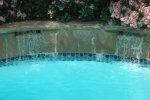See the attached photo for reference.
Note the white deposits on the tile and on the mortar between the individual rocks on the waterfall coping. This is the only place on the pool that has such a problem. Anywhere the water splashes from the waterfall apparently has this white and scaly buildup. I think that it is due to the previous owners (and their pool service's) lack of pH control coupled with a high CH. Although the CH is still 425 ppm, it is lower than what it was (>600 ppm) when I first bought the house and took over the pool.
To correct, I was thinking of maybe painting the areas with a dilute mixture of HCl... say 10:1 of the 31.45%, brushing, and then rinsing. Before I did something like this though, I wanted to pose the idea to the forum. I am doing BBB.
Current numbers are:
water temp: 69 degrees F
ambient temp: 70 degrees F
FC: 6.6 ppm
CC: 0 ppm
TC: 6.6 ppm
pH: 7.4
TA: 80 ppm
CYA: 55 ppm
CH: 425 ppm
Miller Lite: 3
Thanks!
Craig
Note the white deposits on the tile and on the mortar between the individual rocks on the waterfall coping. This is the only place on the pool that has such a problem. Anywhere the water splashes from the waterfall apparently has this white and scaly buildup. I think that it is due to the previous owners (and their pool service's) lack of pH control coupled with a high CH. Although the CH is still 425 ppm, it is lower than what it was (>600 ppm) when I first bought the house and took over the pool.
To correct, I was thinking of maybe painting the areas with a dilute mixture of HCl... say 10:1 of the 31.45%, brushing, and then rinsing. Before I did something like this though, I wanted to pose the idea to the forum. I am doing BBB.
Current numbers are:
water temp: 69 degrees F
ambient temp: 70 degrees F
FC: 6.6 ppm
CC: 0 ppm
TC: 6.6 ppm
pH: 7.4
TA: 80 ppm
CYA: 55 ppm
CH: 425 ppm
Miller Lite: 3
Thanks!
Craig


